Flower Comes in Variations of Purple Blue Yellow White
What kind of flowers are naturally blue? What does blue color even mean? In this comprehensive and detailed guide, you will find a list of flower types, big and small, that have all kinds of blue colors, including, navy blue, dark and light blue.
- Meaning of Color Blue
- A List of Beautiful Natural Flowers with Blue Colors
- #1. Cornflower
- #2. Iris
- #3. Delphinium
- #4. Blue Star
- #5. Hydrangea
- #6. Clematis
- #7. Perennial Geranium
- #8. Periwinkle
- #9. Empire Blue Butterfly Bush
- #10. Brunnera
- #11. Forget Me Not
- #12. Gentian
- #13. Grape Hyacinth
- #14. Hyacinth
- #15. Salvia
- #16. Passionflower
- #17. Bellflower
- #18. Desert Bluebells
- #19. Stiff Blue-eyed grass
- #20. Glory-of-the-snow
- #21. Oxford blue
- #22. Morning glory
- #23. Veronica
- #24. Blue false indigo
- #25. Harvestbells
- #26. Sweet Pea
- #27. Blue Mist Shrub
- #28. Poor Man's Weatherglass
- #29. Blue Orchid
- #30. Veronica Georgia Blue
- #31. Lupine
- #32. Himalayan Blue Poppy
- #33. Love-in-a-Mist
- #34. Lobelia
- #35. Lungwort
- #36. Birdbill Dayflower
- #37. Siberian Squill
- #38. Columbine
- #39. Flax
- #40. Mountain Larkspur
- #41. Aster
- #42. Lily of the Nile
- #43. Globe Thistle
- #44. Monkshood
- #45. Blue Daisy
- #46. Anemone
- #47. Scabiosa
- #48. Sea Holly
- #49. Chicory
- #50. Balloon Flower
- #51. Blue Hibiscus
- #52. Impatiens flower
- #53. Violets
- #54. Blue Calla Lily
- #55. Ipomoea Flower
Meaning of Color Blue
Most of us associate blue color with the sky, the sea, and the endless horizon. It's a dreamy color usually related to one's desires, hopes, feelings and emotions. It is believed that blue is the royal color and refers to authority, power, and class.
It is not a coincidence that we like blue flowers too. The blue color is calming and peaceful and thus, relaxes our state of mind. We also relate it to freshness, attractiveness and classy appearance.
Furthermore, some scientists believe that the blue color is a source of happiness and smiles. An interesting fact is that this color is also related by people to sadness and depression and is preferred by people in all moods (1).
Other scientists relate blue color to tranquility, depth and productivity. It is the color that is perceived to best solve negative emotions like sadness and loneliness (2, 3, 4).
These are the reasons why, even though sometimes subconsciously, we are in love with true blue flowers and very often prefer to have them as a part of our garden paradise.
If you also want to have a blue fairy heaven at home, here are our top 55 of the most beautiful blue flowers which you can use. Enjoy!
A List of Beautiful Natural Flowers with Blue Colors
#1. Cornflower

Cornflowers are annual plants which can make your garden prettier not only with their own beauty but with the fact that they are known to attract butterflies and bees.
Usually, they have around ten petals on each stem. These showy blooms need fully sunny place to flower continuously and moist well drained soil for good development of the roots. They are not appropriate for indoor growing.
In the past, this flower was known as "Bachelor's button flower" because bachelors were wearing it to show their feelings for the girls they loved. This is also the national flower of Poland.
#2. Iris
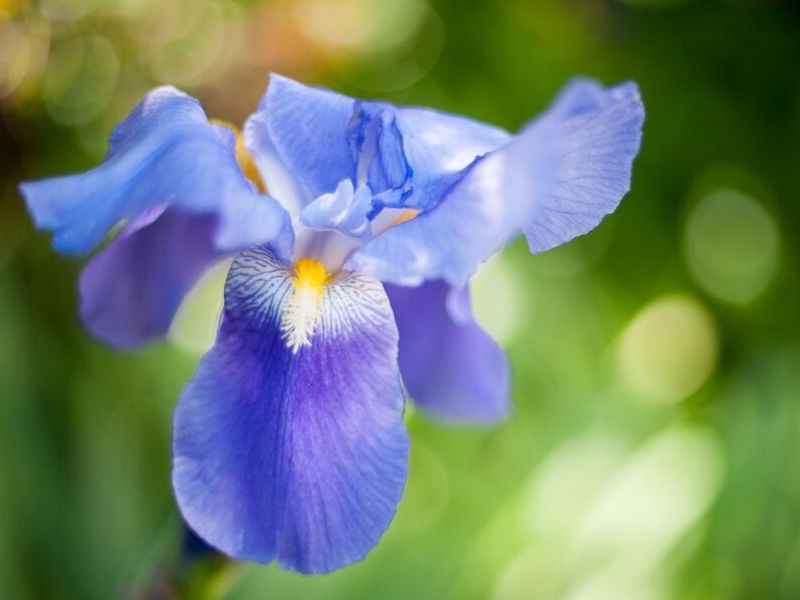
The Iris is a gorgeous flower that comes in different colors and can bring a fresh summer spirit in your garden. The flower has its name from the Greek goddess of the rainbow and blooms during the spring and summer seasons.
Different types of Iris flowers have different height and sizes which makes it perfect for a well-planned all-time-blooming garden. Height varies from 6 inches to 4 feet, making it appropriate for different types of arrangements, garden shapes, forms, and colors.
In order to bloom more and continuously, it needs to be planted in a place that has full sun at least for half of the day time.
#3. Delphinium
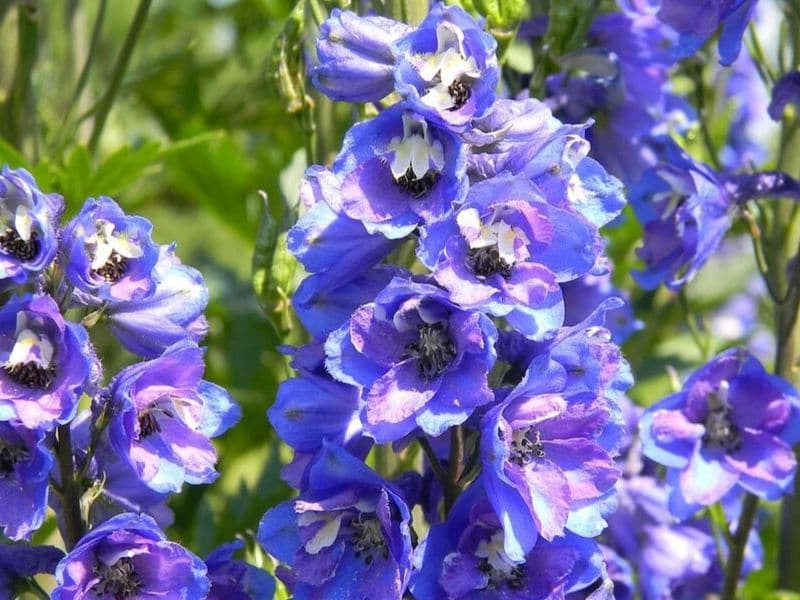
Delphinium flowers are usually a symbol of strong attachment, maybe due to the fact that they grow 3 feet tall and need a wall or something else to attach to in order to grow strong and beautiful.
This also provides you with the opportunity to use them either as a part of your paradise garden landscape and give height to floral arrangements or as cut flowers for indoor vase floral designs. They also need well-drained soil and full sunny light for at least half of the day time in order to bloom continuously.
However, despite their preference for sunny places, blue delphiniums are not friends with very hot weather conditions and prefer summer seasons which are less dry and with not so high temperatures of the air. They also don't grow well in rainy and/or windy places.
#4. Blue Star
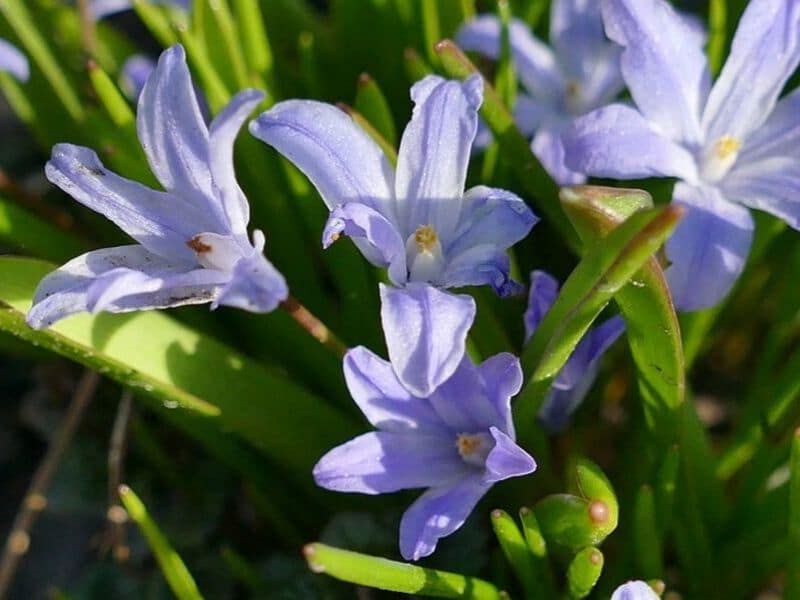
Having its name for its star-shaped blossoms, which are small when considered separately but can form a pretty rich blooming carpet which is enjoyed by the eye for a couple of weeks, this flower can be another star in your garden paradise.
It is relatively easy to take care of, can grow in almost any type of soil (although prefers neutral soil pH) and place. Of course, if you want the flowers to be blooming more and regularly, it is a good idea to plant them in a place where it will have full sun for at least a part of the day.
This flower blooms in late spring or early summer, which makes it a perfect transition between spring and summer flowers in your garden. It is resistant to drought, so do not worry if you cannot water it regularly.
#5. Hydrangea

Blue hydrangeas is one of the most breath-taking garden plants you can have. It comes in many color varieties and the blue has many shades depending on the alkalinity of the soil.
Hydrangea flowering bush starts blooming in the beginning of the spring and this can continue for the whole summer bloom season if taken care for properly. It can survive heavier winter conditions and bloom again the year after.
The leaves fall in the autumn season, if you want to support the greenery of the bush and its blooming during the summer, trim it in the beginning before the rise of the leaves in the spring.
#6. Clematis
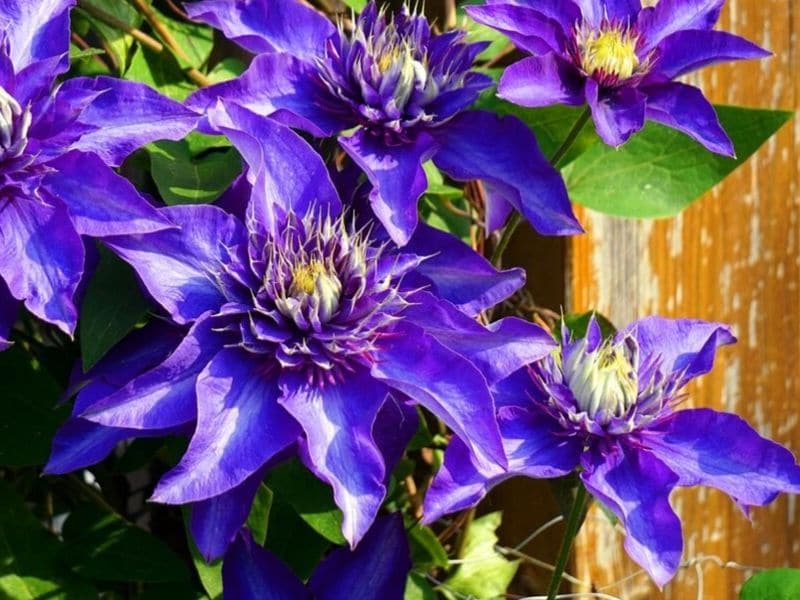
This climbing flowering plant is a very good option for the decoration of fences, walls and different ornaments in your garden. It comes in different colors, but the blue violet version is associated with courage and faithfulness.
It prefers well-drained soil and blooms continuously if exposed to direct sunlight for the whole day time. If you want to achieve a magnificent result and have a breath-taking ornament covered with blossoms, you can pair different colors of clematis with different colors of climbing roses, it will definitely be inspiring and magnificent!
#7. Perennial Geranium
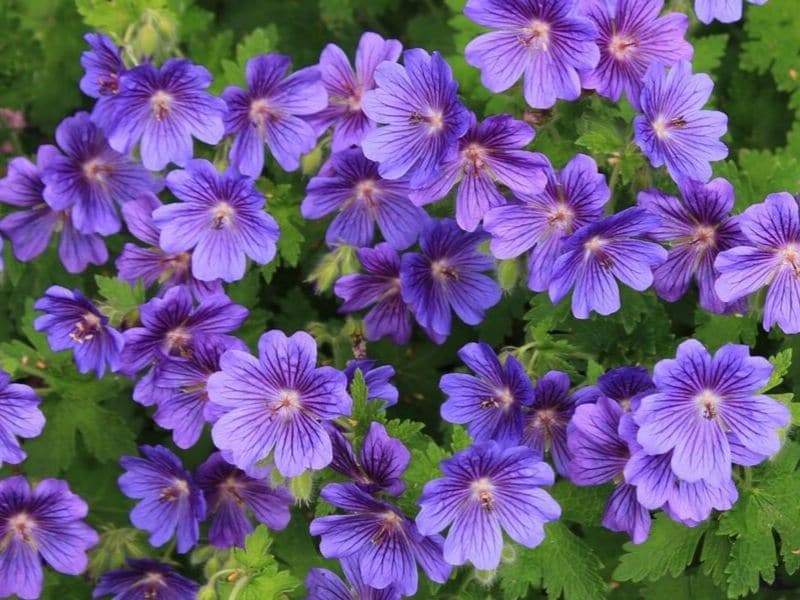
This is one of the flowers that bloom most and longest. You can enjoy its deep blue color from June to the heavy winter period as it is well resistant to cold weather and lower temperatures.
This easy to grow perennial plant prefers well-drained soil and, to grow more and continuously, it should be planted in a place with full sun or part shade. It can be a perfect continuance of your spring flowers like tulips and hyacinths.
#8. Periwinkle
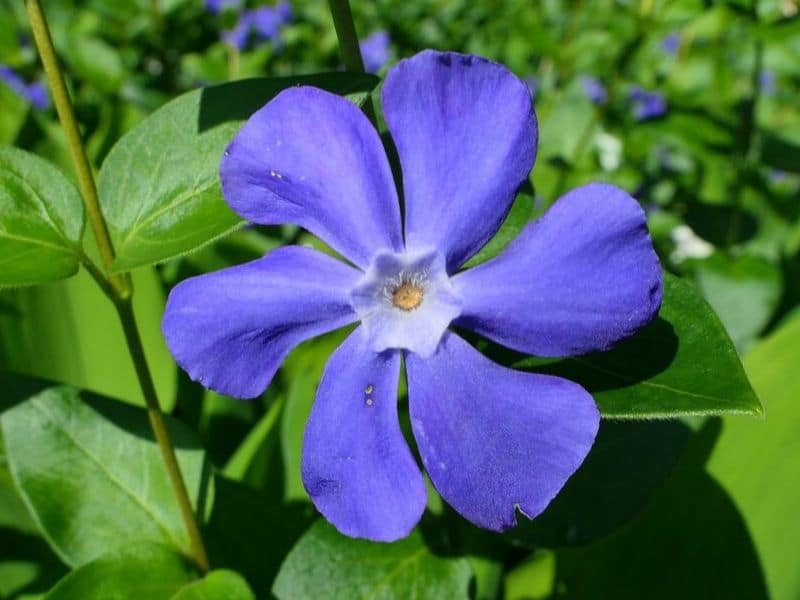
This short bush forms pretty and fragrant purplish blue flowers that have the color of the sky and the sea. It is often used as a ground cover since it grows just a few inches tall and spreads quickly and is a very good option to be used as a foundation cover for taller plants in garden beds.
This plant prefers well-drained soil and enjoys limited sunlight, so it is a good idea to plant it on a partial shade where it will still have its sunshine but will also be protected from burning.
However, once the roots and the plant are well established, they are well resistant to drought and need less than moderate watering, which makes it very easy to grow and care.
#9. Empire Blue Butterfly Bush
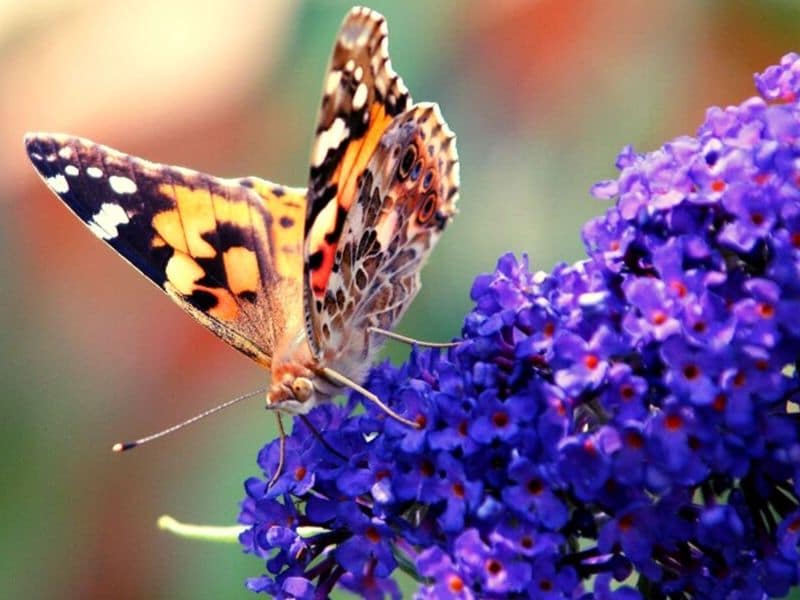
This flower, also known as Buddleia, is very aromatic and this is one of the main reasons why it attracts many butterflies and hummingbirds, making it a real treasure for your garden. It has lance-shaped leaves with blooming branches covered in little violet blue flowers.
It prefers to grow in well-drained soil and enjoys full sunlight during the whole day time, so make sure you plant it in such a position in order to ensure long and continuous blooming.
#10. Brunnera
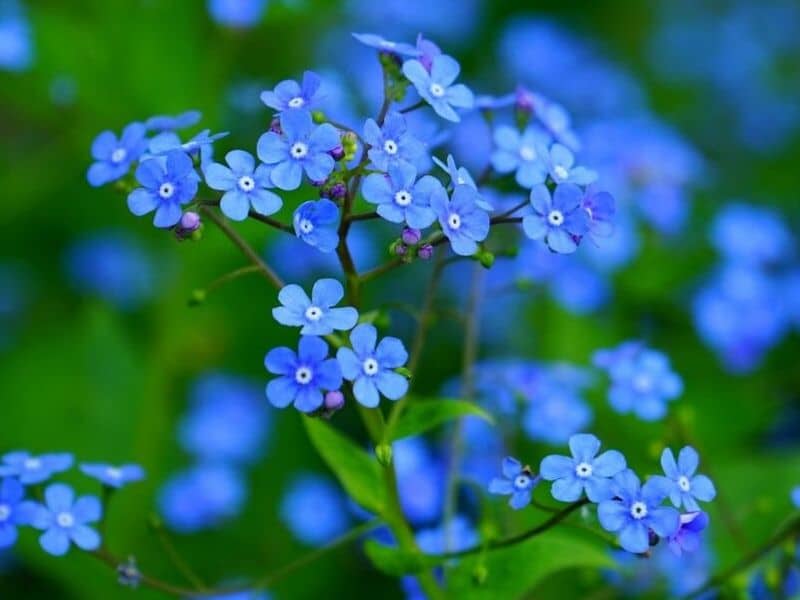
This is a five-petal flower with sprays above the dark green foliage and blooms in early spring which is why it is often perceived as the early bird of the blooming season.
It prefers well-drained soil and should be planted in a shadow place in order to grow strong and bloom regularly.
#11. Forget Me Not
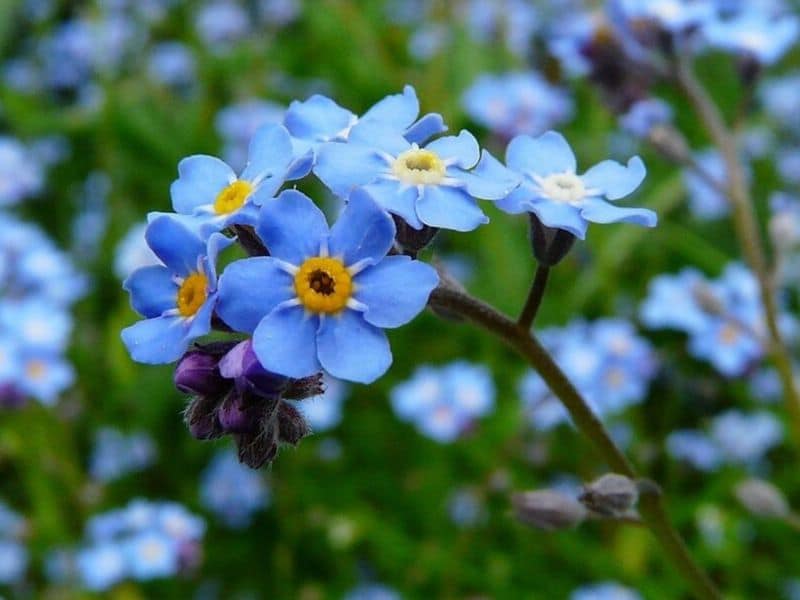
The Forget Me Not flower has its name from a legend dating back to the 15th century stating that whoever was wearing it, would not be forgotten by their loved ones. This tiny light blue flower with yellow stamens is blooming in the summer season and can be a beautiful colorful accent to your blooming garden.
This plant grows strong in moisture and shady position with no direct sunlight during most of the day time. It is a very good option for ground cover.
Keep in mind that this flower self-seeds and spreads relatively fast, so plant it in a place where you don't mind to cover a larger area than the initially planted one.
#12. Gentian
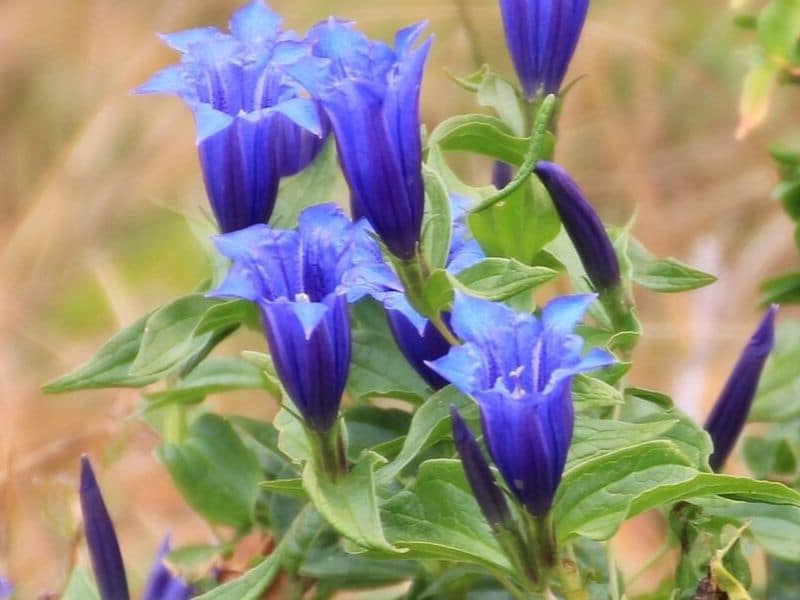
Being the symbol of femininity, this unconventional flower can mostly be found in Europe. Its distinctive shape and color make it appropriate for unconventional garden designs and unique landscapes.
It is known to attract butterflies and hummingbirds which is also an argument to have it if you want to transform your backyard or garden into a fairytale scene with no effort. It prefers well-drained soil and a place with full sunlight or partial shade.
It should be noted that this flower is very challenging to grow and care in a garden as, originally, it is a wild alpine plant. Specific care would depend on the region.
#13. Grape Hyacinth
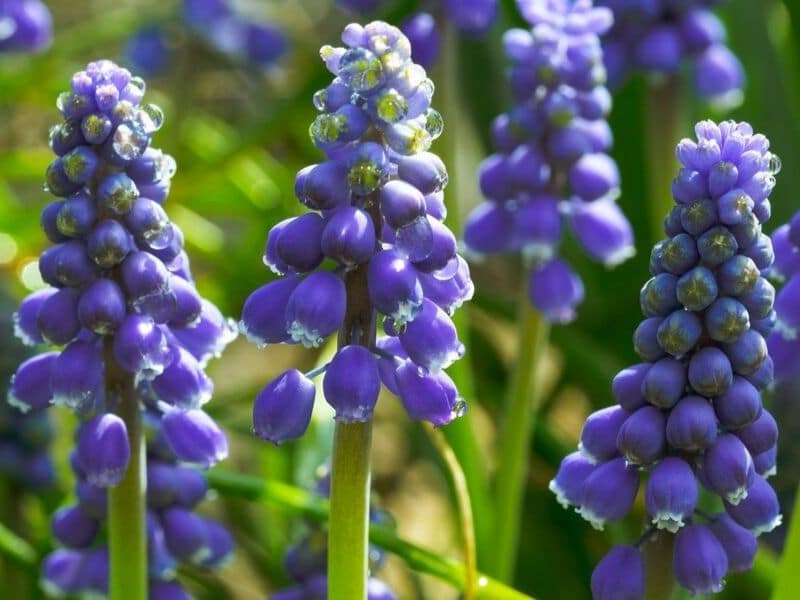
This flower, which is very often mistaken with hyacinths, is blooming in mid-spring and is associated with the beginning of the blossoms' season. In many cultures, grape hyacinth is a symbol of trust.
Nowadays, this flower is often used as a colorful addition to floral decorations and an accent in gardening designs. Keep in mind that the grape hyacinth bulbs are spreading relatively quickly, so you might want to plant them in a spot that you prefer to be covered with their blue to purple flowers. It enjoys well-drained soil and needs full sunlight or, at least, partial shade.
#14. Hyacinth
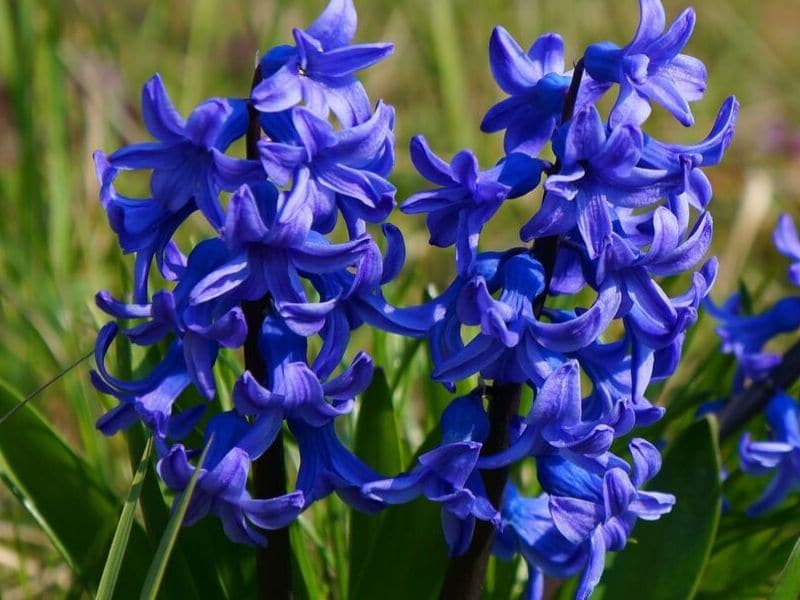
Hyacinths are gorgeous spring flowers with distinctive sweet and lingering fragrance which has been admired by royal families throughout the ages and thus, have become a must for palace gardens and mansion parks.
Nowadays, hyacinths are everywhere, from parks to home gardens and indoor pots. The distinctive scent and bell shaped flowers cannot be mistaken and add to the beautiful floral blossoming which is mainly in the spring. In the past extracts of hyacinths have also been used in perfumery and cosmetics.
#15. Salvia
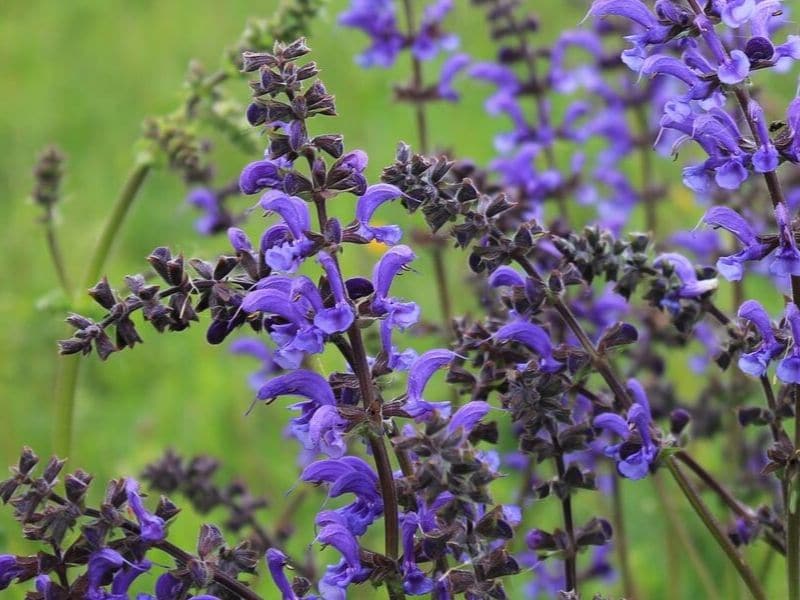
This flower, also known as wild sage, comes in several colors but the blue one is considered as one of the prettiest. It prefers well-drained soil and full sunlight during most of the day time.
Once its roots are well developed, this flower is resistant to higher temperatures and drought, so it does not require sufficient efforts to grow and care. Salvia is a part of the mint family and you can use it as a spice or tea ingredient in the cold winter evenings – it's delicious!
#16. Passionflower
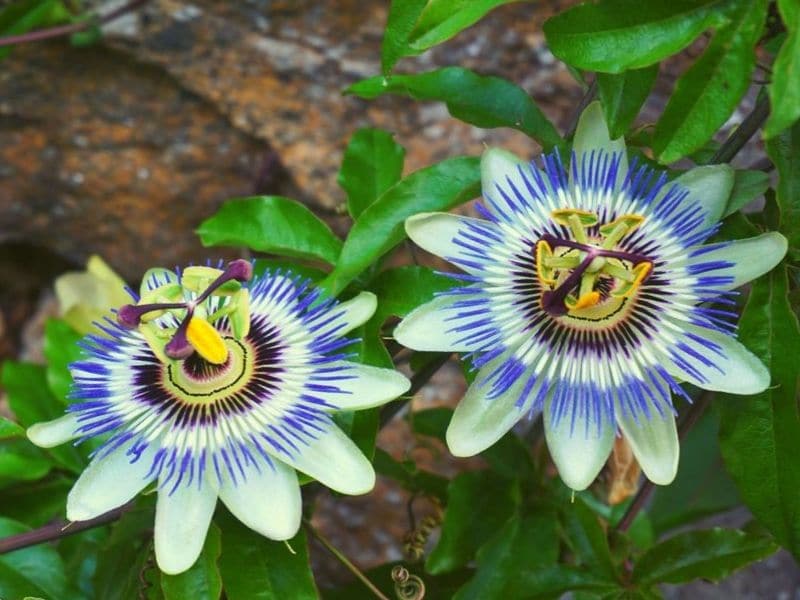
The passionflower vine is one of the most breath-taking flowers you can have for ornament decoration in your garden. You can often see it covering fences and walls and heavily blooming all summer and early autumn.
It comes in a variety of colors but the blue is said to be one of the most magnificent. This flower is relatively easy to grow as it is resistant to severe winter conditions and re-grows every next year.
This flower is very beautiful even when it is not blooming due to its pretty green leaves and up to 33 feet size. It prefers well-drained soil and heavy sunlight.
#17. Bellflower
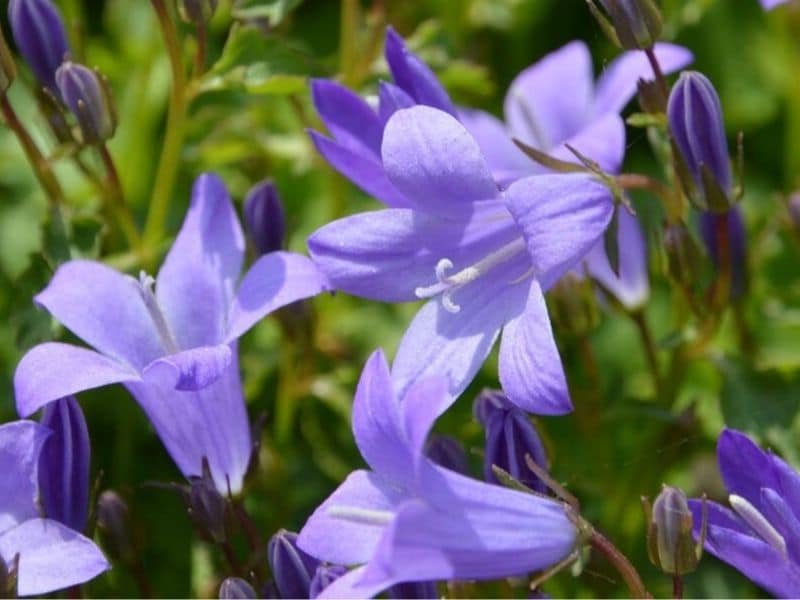
As the name suggests, this plant has bell-shaped blooms and comes in different colors (from white to purple), the variety with lavender blue flowers being one of the most magnificent.
Due to its height, bellflower, also known as campanula, is also preferred for cut flower and interior vase arrangements. This flower is very often associated with fairy tales and this makes it an extremely pretty and appropriate addition to your garden.
They enjoy a lot of sunshine and well-drained soil, but can also grow in semi-shadow with no problem.
#18. Desert Bluebells
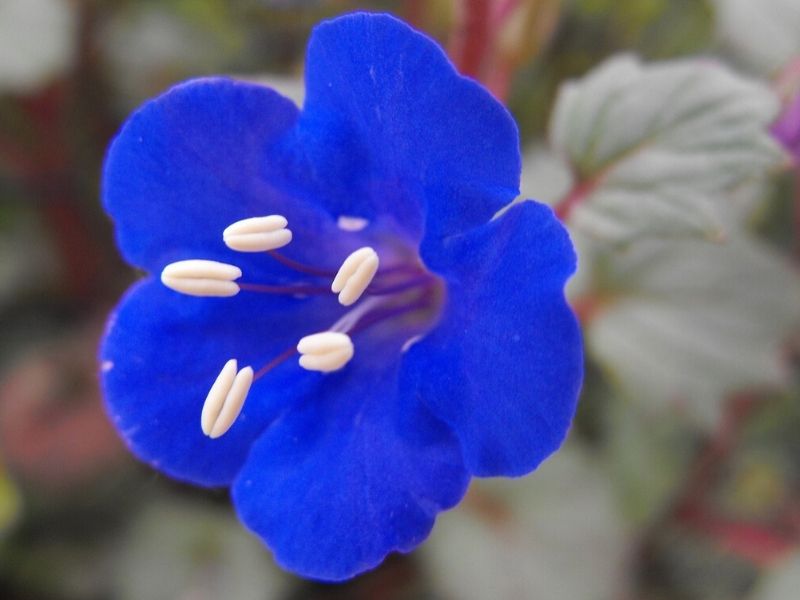
As the name suggests, this flower, also known as phacelia campanularia, enjoys sandy and dry areas and is drought tolerant which is why it is considered easy to grow and care and do not need regular watering. This is also one of the reasons why it enjoys well-drained soil and heavy sunlight.
#19. Stiff Blue-eyed grass
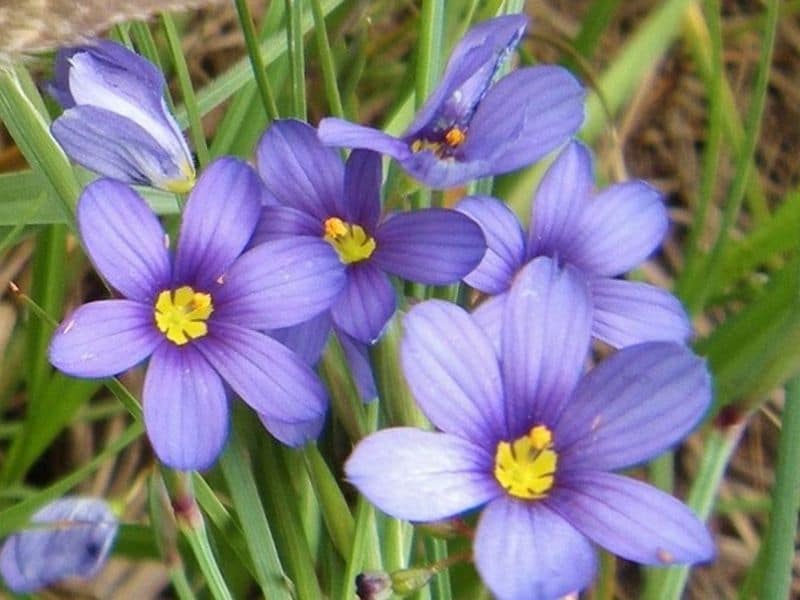
Despite its name, this plant is not a grass but rather a tall flower with tender soft blue blossom with yellow centers on the top. It is relatively easy to grow and care as it adjusts to different types of soil and also attracts different birds and butterflies. It grows strong and blooms more if planted on a sunny place with well-drained soil.
#20. Glory-of-the-snow
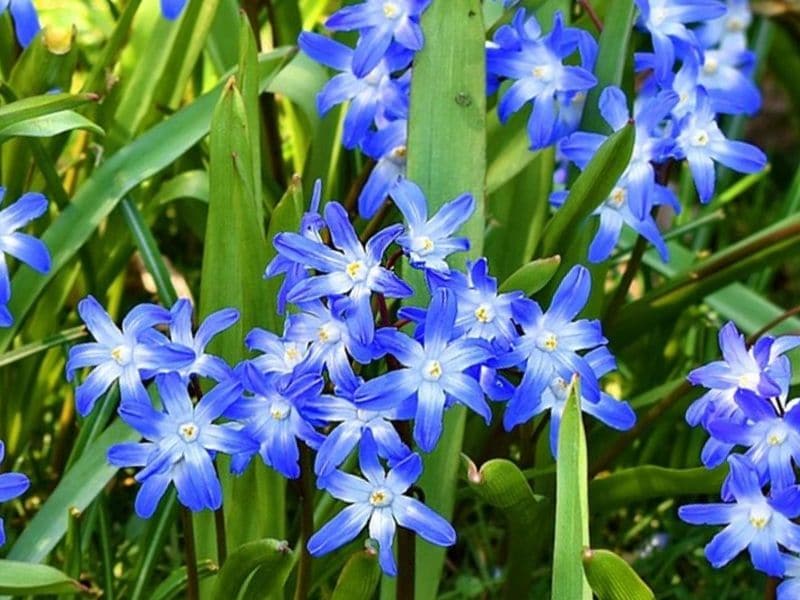
As the name suggests, these star shaped flowers very often start blooming even before the snow melts which makes them some of the first bloomers indicating the soon-to-come spring. The flowers usually bloom to mid- or late spring and the bulbs are likely to spread and give you a higher number of new flowers in the year after.
The flower prefers well-drained soil to prevent rotten and full sunshine or partial shade for the majority of the day time.
#21. Oxford blue
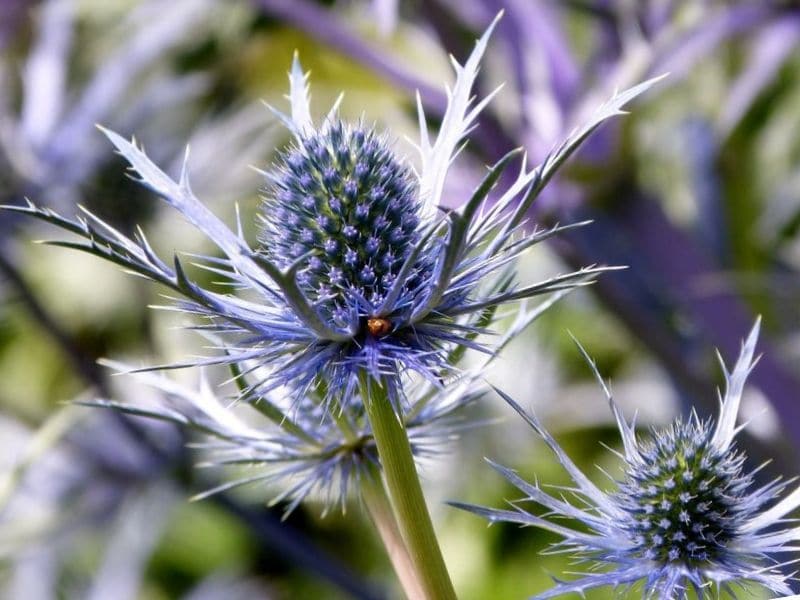
This flower is also classified among the distinctive and unconventional garden beauties. It has clumps of thin leaves with sharp white veins and cone-shaped flowers with spiny bracts.
It attracts different birds, butterflies, and bees and is partially poisonous, so it is not a good idea to plant it in gardens visited by children and pets. This is also why you need to use gloves when you plant/re-plant/touch this flower and be careful to not ingest it as it can have negative consequences for your health.
If you still decide to include it in your garden paradise, make sure you plant it in a sunny place with well-drained soil and not water it too much to prevent rotten.
#22. Morning glory
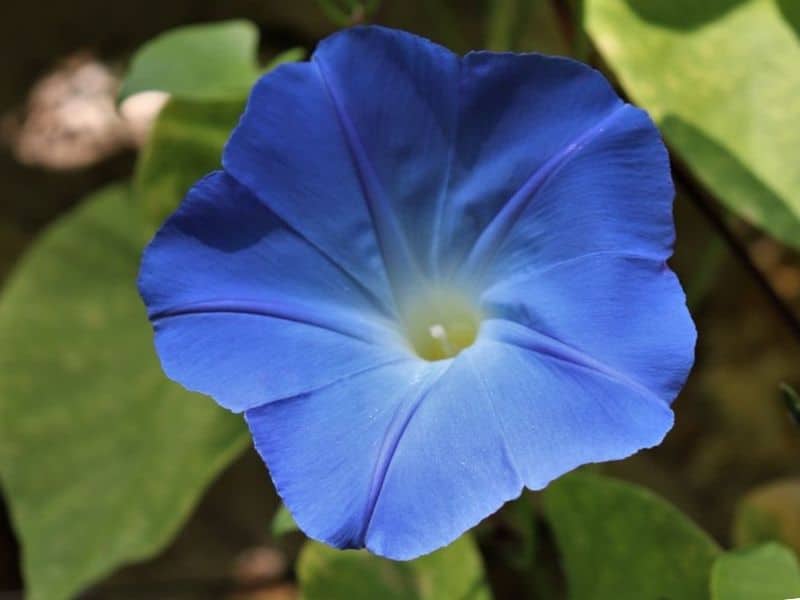
Also called dwarf morning glory, blue dawn flower or koali awa, the morning glory flower is blooming during the day showing its pretty saucer-shaped blossoms that come in different colors like sky blue, yellow, purple and red, and closes its flowers during the night.
This is very often used for ornamental decoration for different events due to its magnificent flowers and their relatively short life. Morning glories prefer well-drained soil and a lot of sunlight to start blooming, which can be a couple of months after they have been planted. However, once you get started, you will have beautiful flowers for long!
#23. Veronica
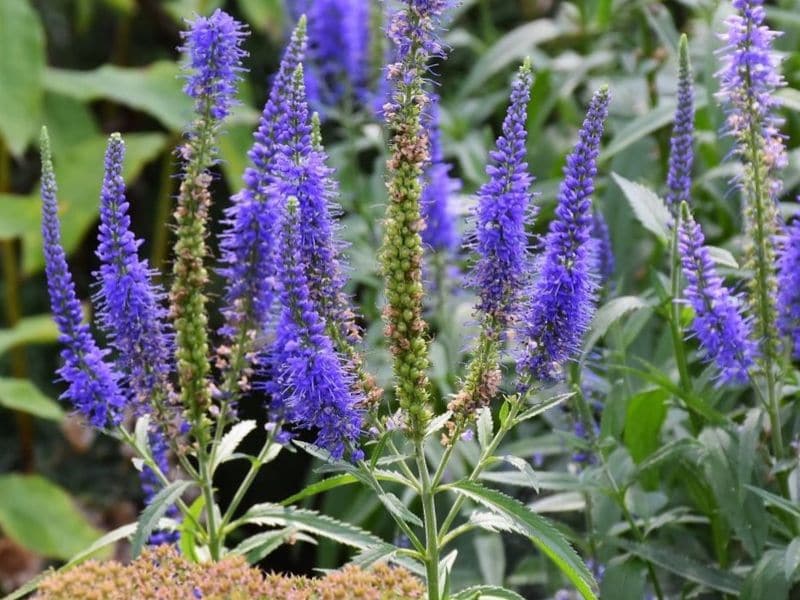
This flower has an impressive height and grows up to 3 feet. It makes long spikes of small light blue blossoms. It is preferred by gardeners mainly due to its resistance to changing conditions and its relatively long blooming period covering three seasons, including spring, summer, and autumn.
It is also found attractive by butterflies and hummingbirds which provides you with the potential of having your own back-yard fairy tale.
#24. Blue false indigo
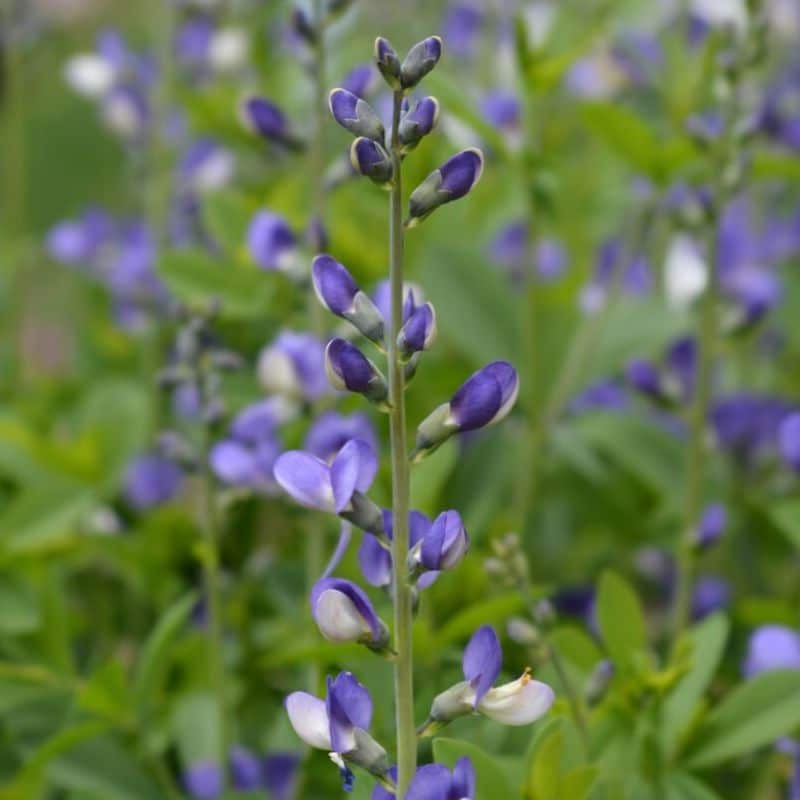
As can be assumed by the name, this flower has been used for making blue dye in the past. It has a strong blue color and stems covered in green leaves and small blue blossoms.
It prefers well-drained soil and full sun during most of the day time, but it can also grow in partial shade. It is a good idea to plant this flower when you are sure where you want to grow it as it is not very resistant to changes and re-planting due to its deep root systems that it develops.
If you decide to re-plant it once it has developed well, the chance of losing it is relatively high.
#25. Harvestbells
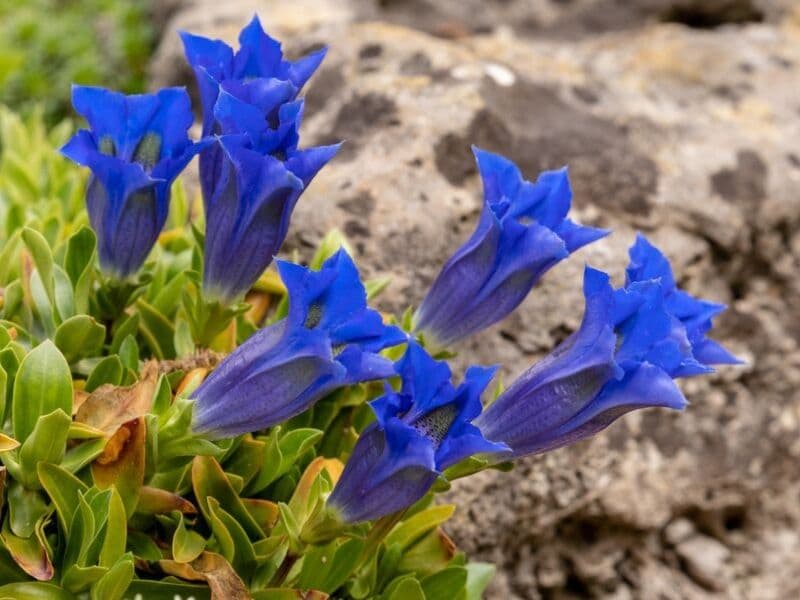
Also known as Gentiana saponaria or the soapwort gentian, it is a low-growing flower, which makes it perfect for ground covering purposes in your garden. It offers a unique palette of colors when used to cover the ground with its bright blue flowers, green leaves and partially red stems.
It also has a remarkable fragrance which is why it is known to attract many bees, birds, and butterflies. It grows well in partially sunny places and sandy soil but is adjustable to other soil types as well.
#26. Sweet Pea
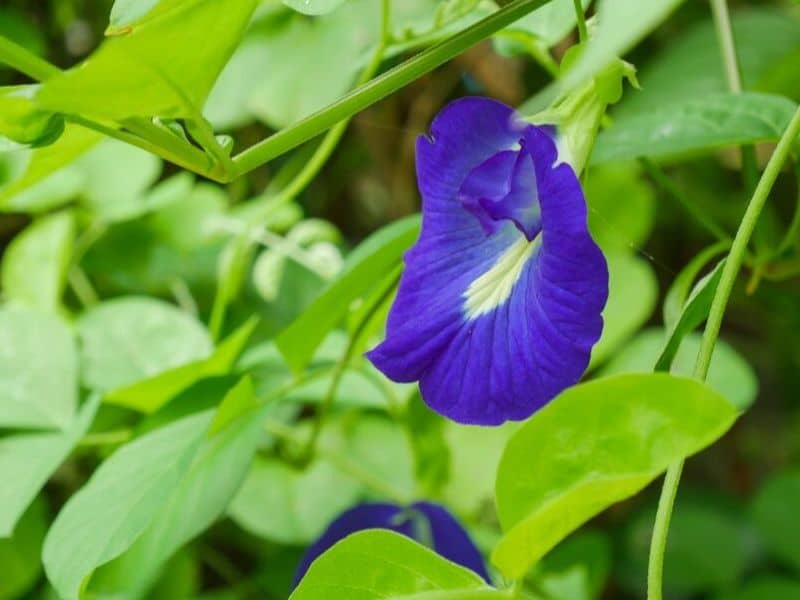
This pretty blue flower is most popular for its fragrance which is often used in perfume production. It is a flower which is considered to be relatively difficult to be grown in home garden conditions, but if successfully planted and grown, it is resistant to almost all challenges it might face.
In general, sweet pea enjoys well-drained soil and full sunlight, so if you want to give it a try, you have to ensure such a place that offers these conditions.
#27. Blue Mist Shrub
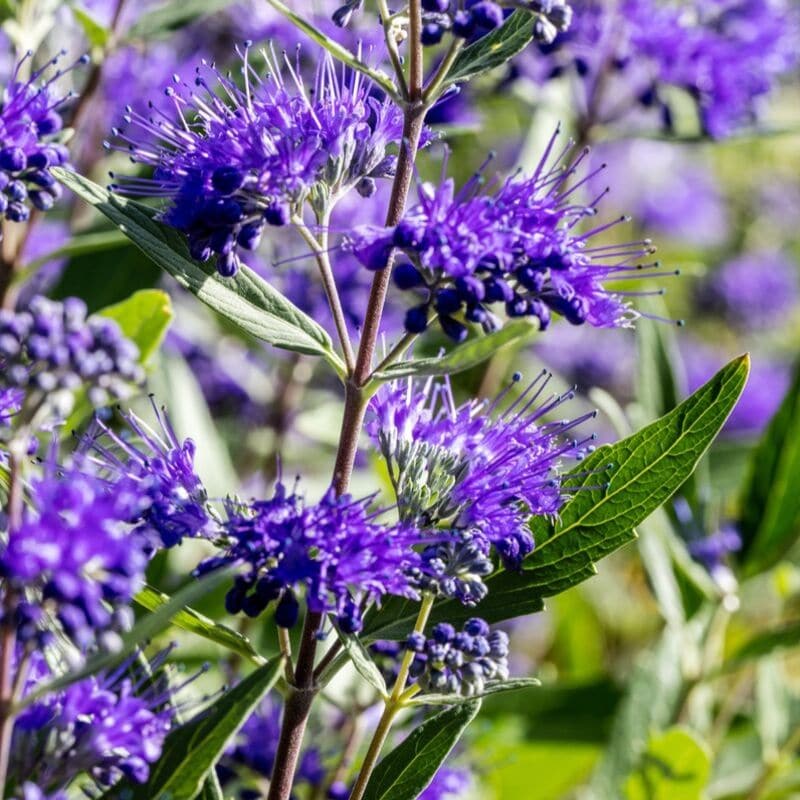
As it can be judged by the name of this flower, blue mist shrub or caryopteris creates a mist of blue beauty. It blooms in late summer which makes it a perfect continuation of summer flowers.
Due to the fact that this flower is full of nectar, it is known to attract many bees around. It prefers well-drained soil and full or partial sunlight for the majority of the day time.
In order to ensure that flowers bloom strongly in late summer, it is a good idea to cut it every spring, encouraging the creation of new stems with more blossoms.
#28. Poor Man's Weatherglass
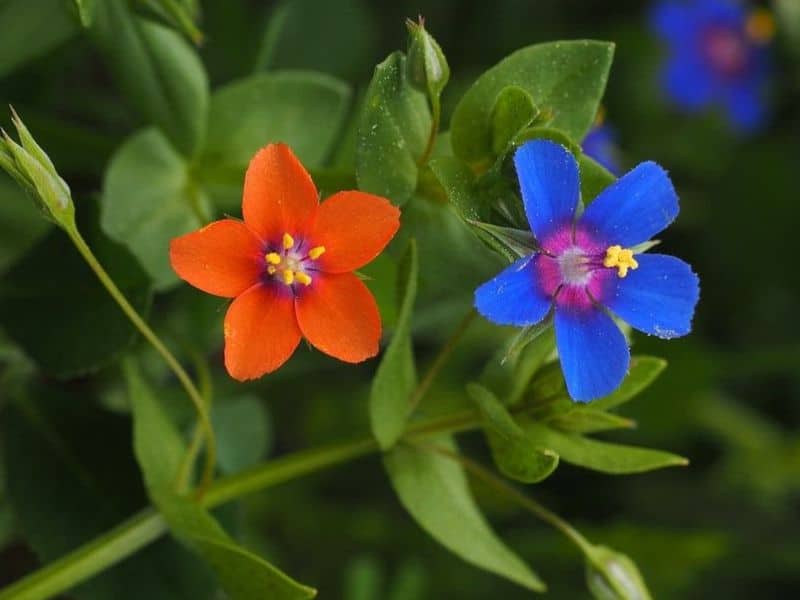
This flower has been known by many different names including poor man's barometer, red chickweed, red pimpernel, lysimachia arvensis, anagallis arvensis, blue-scarlet pimpernel, and scarlet pimpernel.
In the past, this flower has been used to make weather forecasts and this is still a funny reason to choose it as a part of your garden paradise. It is believed that the flower only blooms when sunny days are coming and closes when rain or storms are soon expected.
Once its root network is well developed, the flower is very resistant to changing conditions in the environment which makes it relatively easy to grow and care. It prefers well-drained soil and partial sunlight.
#29. Blue Orchid
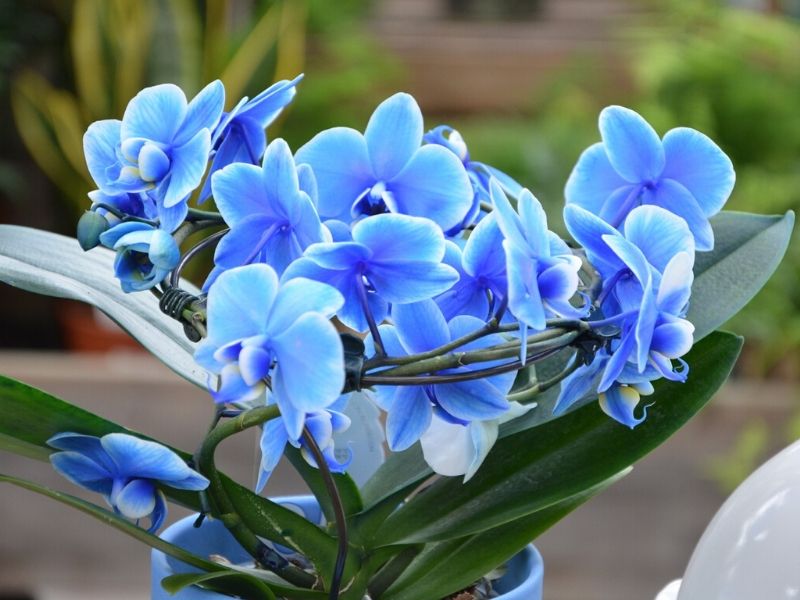
Orchids are becoming more and more popular among flower lovers due to their beauty, tender colors and royal presence. They come in a wide variety of shapes and colors but the blue orchid is considered to be one of the rare garden gems.
If you never had an orchid before, you need to know that these flowers do not grow in ordinary soil but rather a mix between charcoal and bark. Wood chips can also be used. Blue orchids like moderate watering but not with big amounts as the roots will rot otherwise.
Orchids are best grown in glass or transparent plastic pots or containers as the roots need daylight to develop properly.
#30. Veronica Georgia Blue
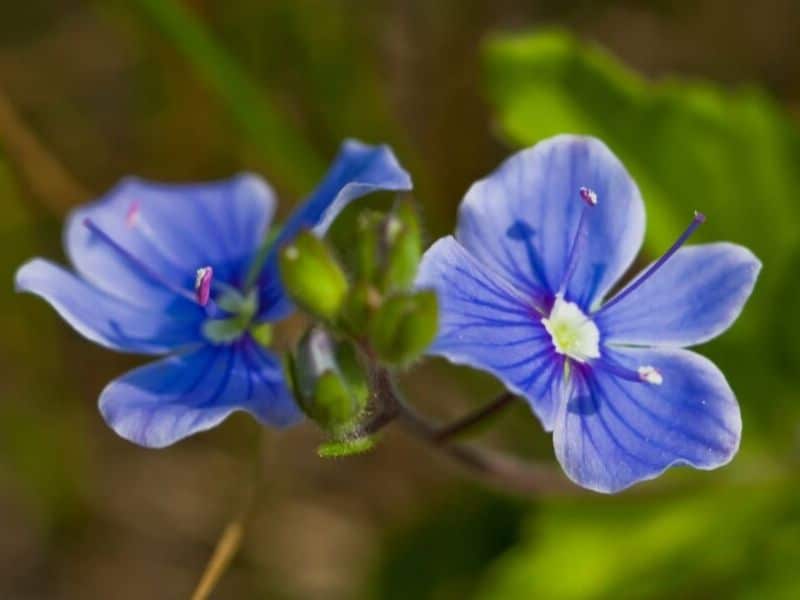
This is a low-growing flower that is very often used as a ground cover for spring bulbs as it blooms in the same period. It is relatively easy to grow and care and prefers well-drained soil and full sunshine.
#31. Lupine
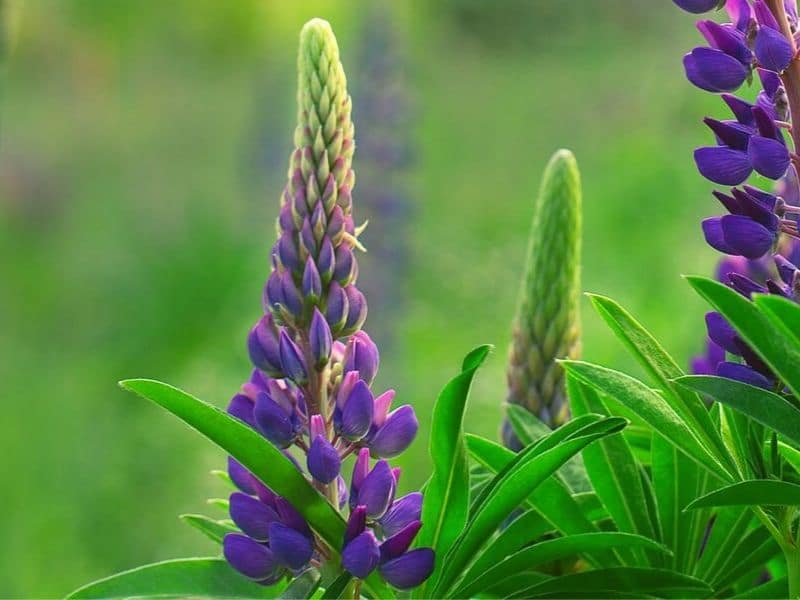
Lupines are tall flowers which makes them a pretty addition to any floral vase decoration. It prefers well-drained soil and full sun to bloom longer and more.
As this flower needs a cool period to rest in order to develop strong, if you plant it from seeds, it is a good idea to store them in the fridge for a week wrapped in paper towels.
#32. Himalayan Blue Poppy
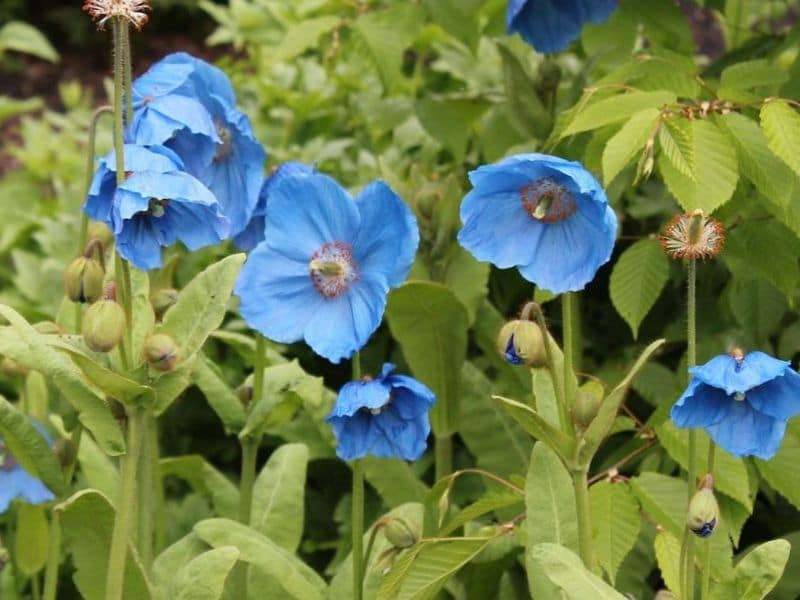
This is the rarest color option of a poppy as it mainly comes in other colors, including white, yellow and red. Himalayan blue poppies grow only in certain environments and are relatively specific in terms of preferences for weather, sun, and soil and can mainly be found in Tibet and some regions of the USA.
It is considered to be difficult and challenging to grow but if you still want to try, you might want to put efforts into copying the conditions of its native nature and climate in Tibet and ensure well-drained soil and partial sunlight which it needs as a start.
#33. Love-in-a-Mist
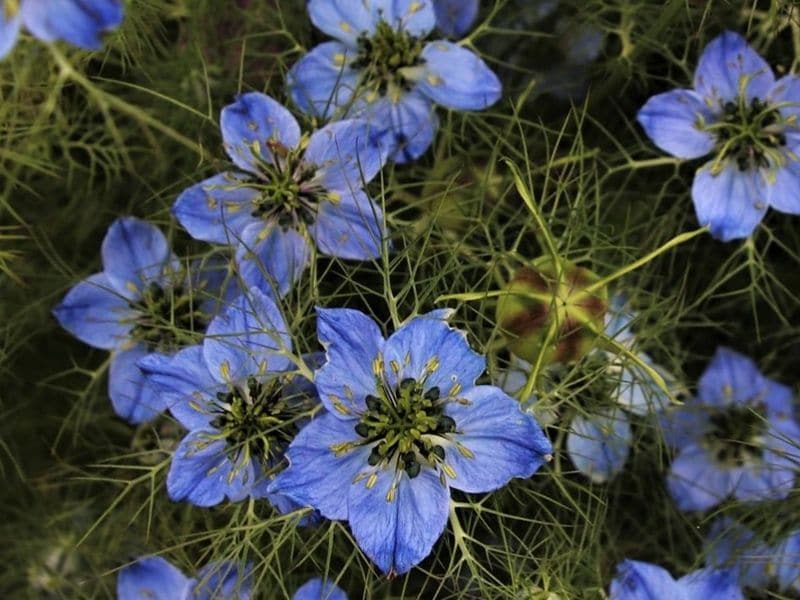
Love in a Mist or Nigella damascena, is one of the easiest to grow and care due to it being adaptive to different soil types, although preferring rich and fertile ones. It blooms mainly in the spring, so it can become one of the starters of your garden blossoms for the new season.
It prefers well-drained soil and full or partial sunlight, so make sure you plant it in a place that would provide it with access to such. Keep in mind that this flower is not resistant to change and re-planting but can be easily spread through seeds collection.
#34. Lobelia
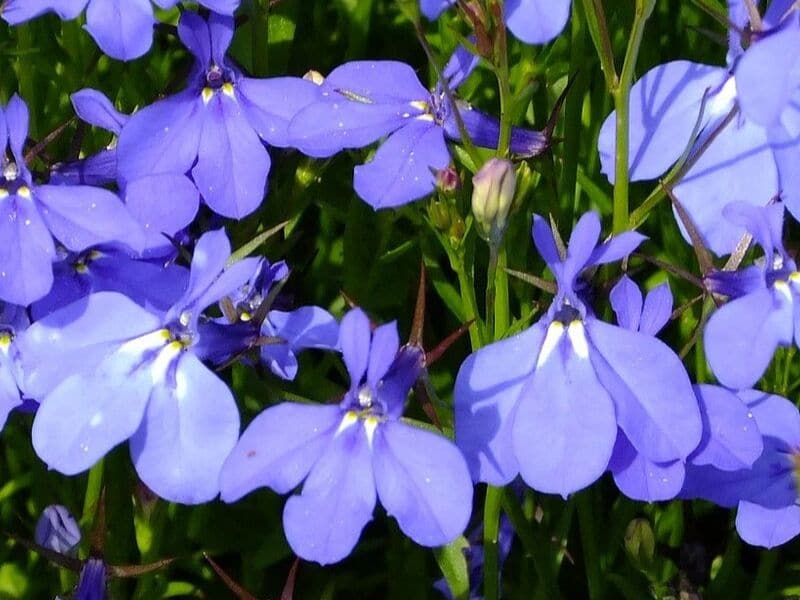
This stunning blue flower is relatively easy to grow. It enjoys cooler weather with no direct sunlight and can also be used for hanging baskets decoration completing your paradise garden design. These annual plants bloom during the whole summer and early autumn until the first frost.
Lobelia prefers well-drained soil but can adjust and adapt to almost any type. It is easy to plant and grow from both seeds and transplanted parts of a grown flower.
#35. Lungwort
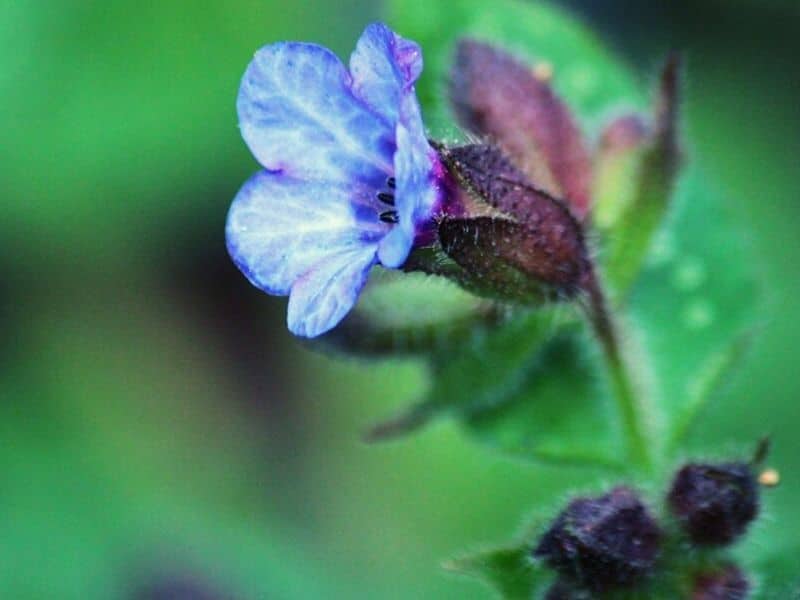
This is a very pretty tiny blue flower that grows in wild forests and is relatively easy to grow and care in home-garden conditions. It prefers well-drained soil and shadow position which reminds it of its native wood landscape.
To replicate its original setting, you might cover the soil with leaves and wood chips which would help it bloom more and grow stronger.
#36. Birdbill Dayflower
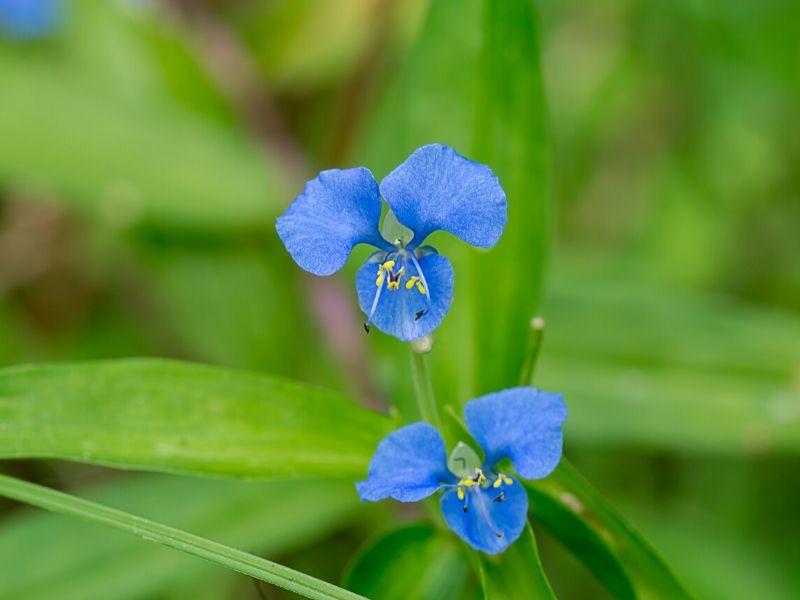
As it can be assumed by the name, this flower only blooms for a day but is a pretty addition to any garden. Blossoms come from one stem as, usually, there are three blue petals on each.
Birdbill dayflower or commelina dianthifolia is very appropriate to be grown in containers where you can combine it with other longer-lasting plants. It prefers moist and well-drained soil and full sunlight or partial shade during most of the day time.
#37. Siberian Squill
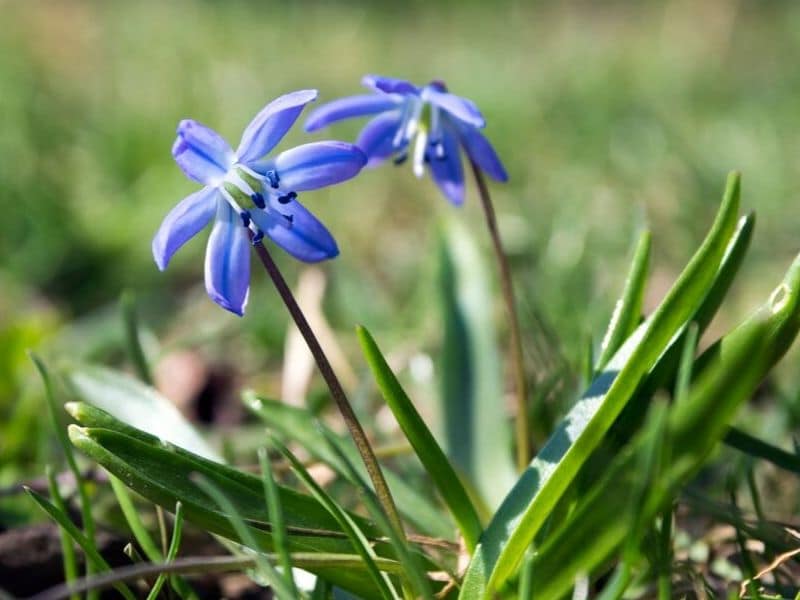
It is no coincidence that the flower is named after Siberia – if it is offered a cool winter to rest, it will enjoy your eye with a sea of blue color blossoms in early spring.
It is a low-grown flower that is perfect for the ground cover of your yard. It enjoys well-drained soil and full sunlight for the majority of the day time.
#38. Columbine
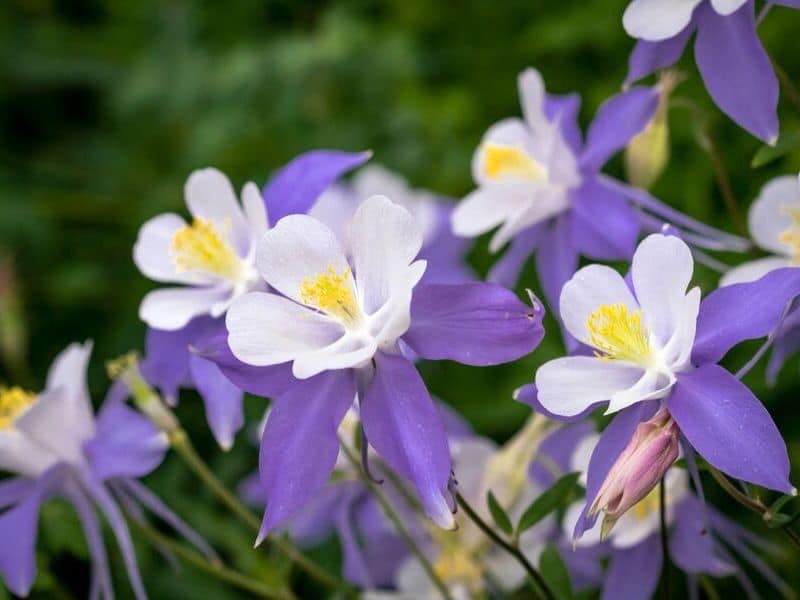
This flower also comes in many color versions, including blue, pink, red, yellow, violet and white. It is preferred by gardeners for its delicate blossoms and colored sepals which contribute to a fairy design of the landscape.
It is relatively easy to grow and care flower, which is also preferred because it attracts hummingbirds. It prefers well-drained soil, mild climate conditions, and full sunshine, but can also grow in partial shade.
In order to protect this flower during the winter period, it is a good idea to put mulch or fertilizer to keep the soil moist and insulated.
#39. Flax
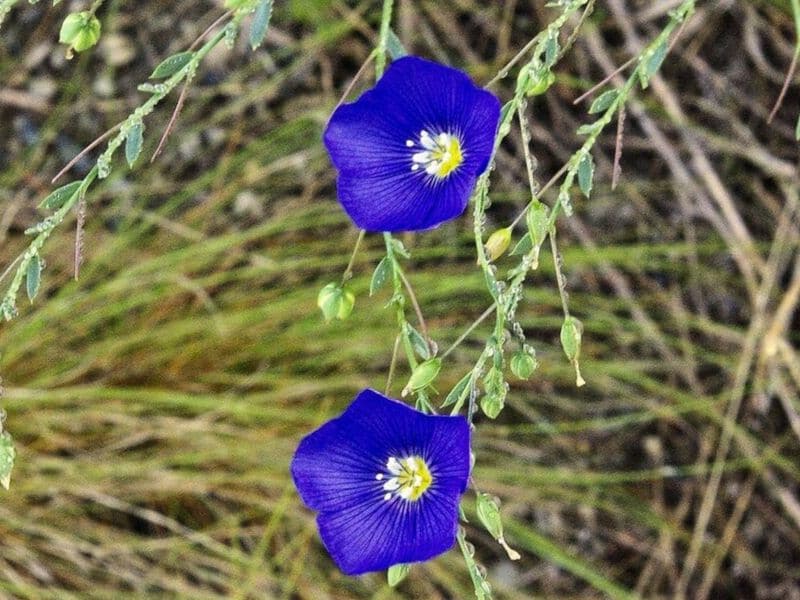
This flower is gorgeous and beautiful but it blooms only for a day or two, so if you want to add a colorful blue spot in your garden, make sure you plant many of it to enjoy its beauty for longer.
Flax is the source of linen and linseed oil and is very popular for this reason in some regions but it also makes a beautiful garden flower.
It prefers well-drained soil and direct sunlight for the majority of the day time, however this flower is very adaptable to different types of soils and weather.
#40. Mountain Larkspur
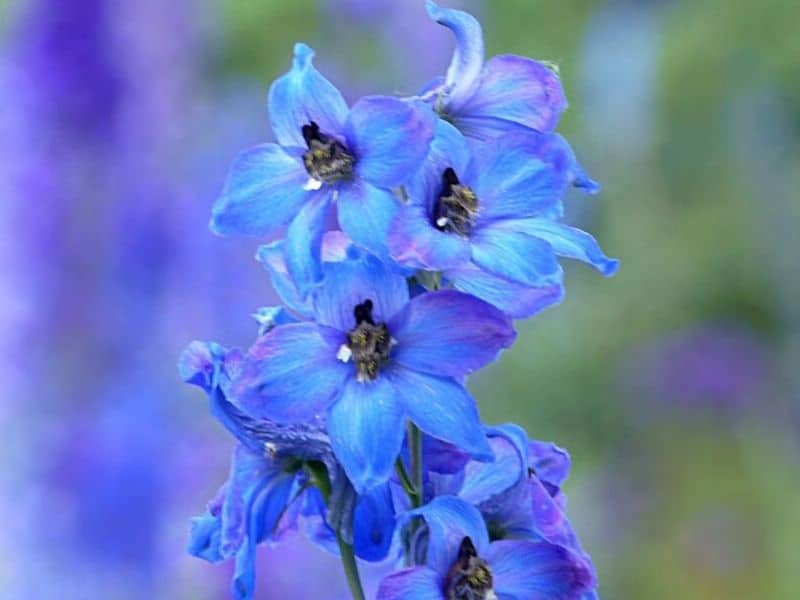
This is another very poisonous flower which makes it inappropriate for gardens that are accessible by kids or pets. Despite that, this flower is very pretty with its numerous flowers on a single stem.
As this is a wildflower which is common for rocky hills and desserts, it is rather challenging to grow and care in home garden conditions, but if you still decide to try, make sure you plant it in moist and well-drain soil and put it on a very sunny place.
#41. Aster
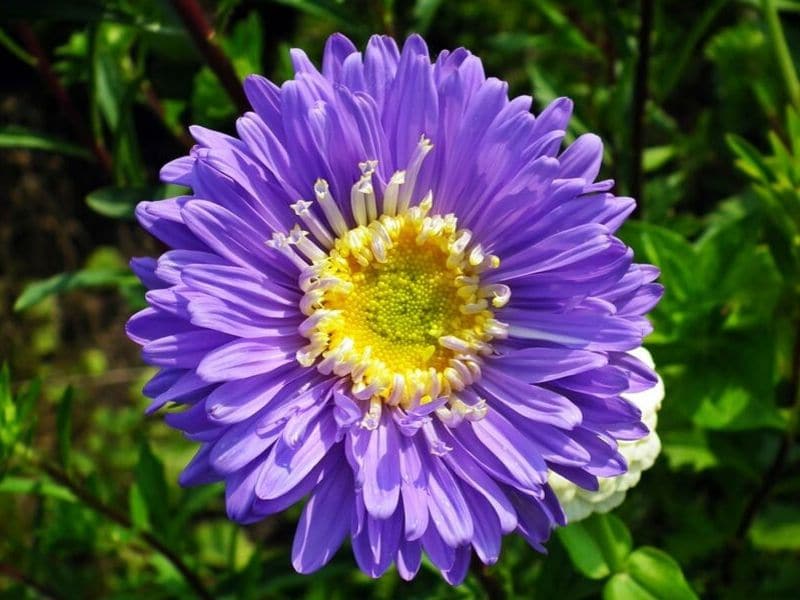
This is one of the late bloomers and is a perfect flower to finish the blossoms' season in your garden. It comes in a wide palette of different colors as, except the blue, you can also find it in pink, yellow, white, red and purple.
In ancient times, people have believed in the magic power of the flower and that it was sending evil away which is why it has been a part of many rituals and traditions.
It blooms in autumn and, if the weather is not very harsh, can also enjoy the eye with stunning flowers in the winter too, which is why it is often called "the frost flower".
#42. Lily of the Nile
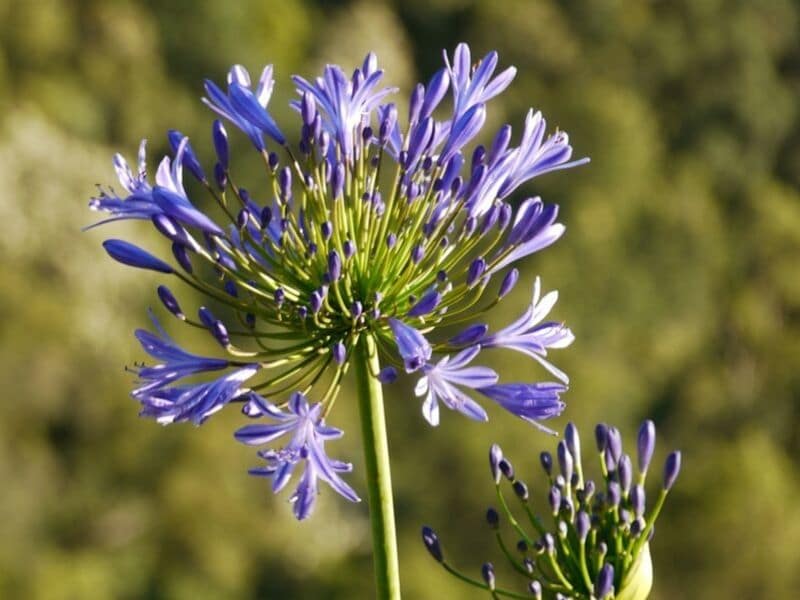
This African lily flower is often known as "Agapanthus" directly translated from Greek as "the flower of love". It blooms in the summer season forming large clusters of blue or white flowers which makes it a perfect addition to a garden which has spring bulbs and wants to continue blooming after they dry.
It prefers well-drained soil and blooms more and longer if planted on a sunny place with direct sunlight for most of the day time. If grown and cared for properly, it can bloom for the entire summer and early autumn.
Keep in mind that if you are growing this flower in regions with heavy winter conditions, it is a good idea to keep it in a pot and store it indoors during time periods with lower temperature as it is not cold-resistant.
#43. Globe Thistle
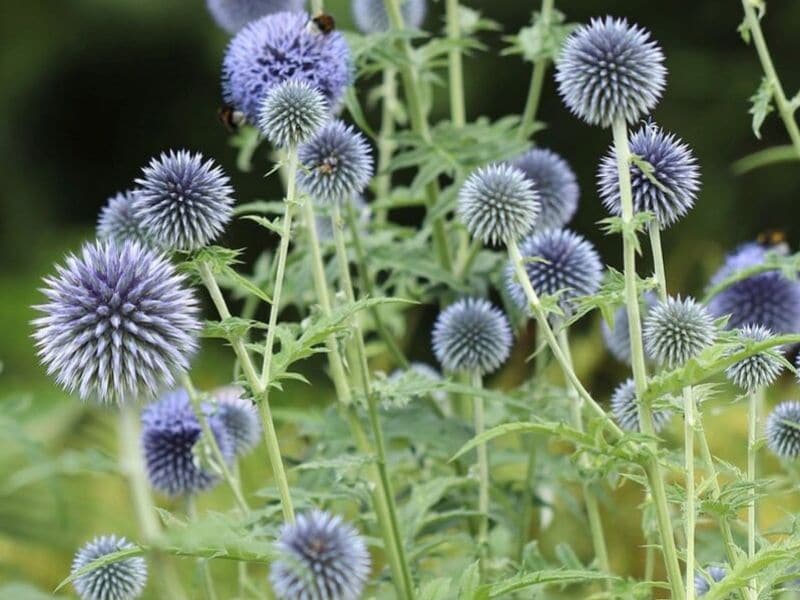
This blue flower attracts with its distinctive globe-like flower and for attracting butterflies and bees. It is very often used by florists in dry floral decorations, so you can cut it when the flower is dry and keep it at home for enjoying its beauty until the next blooming season.
In the garden, this flower can give you perfectly round shape of blue blooms accompanied by prickly green leaves. It prefers well-drained soil and grows stronger on places with full sunlight during most of the day time or, at least, partial shadow.
#44. Monkshood
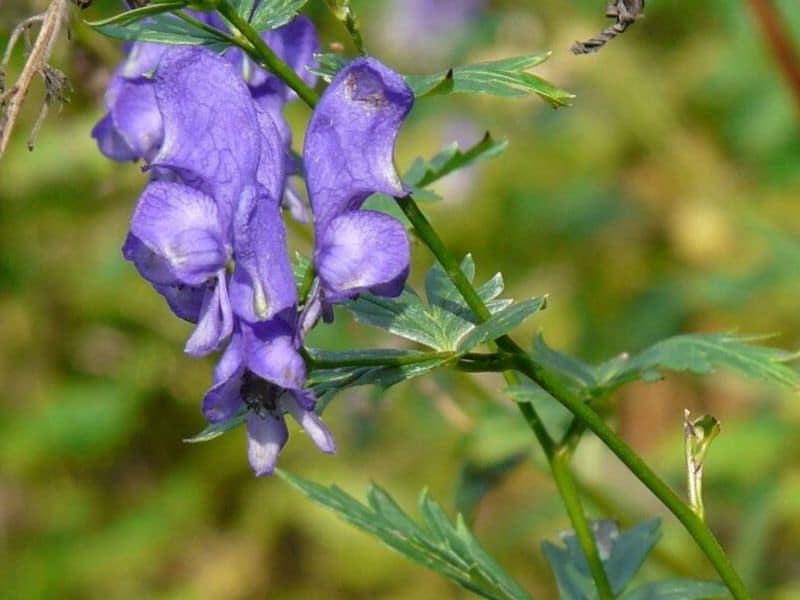
This flower has a distinctive shape and looks extraordinary. It is also known as "wolf's bane" and is extremely poisonous, which makes it totally inappropriate for gardens which are visited by kids or pets.
If you still decide to grow it in your yard, make sure that you ALWAYS use gloves when you touch it and wash your hands carefully after that.
#45. Blue Daisy
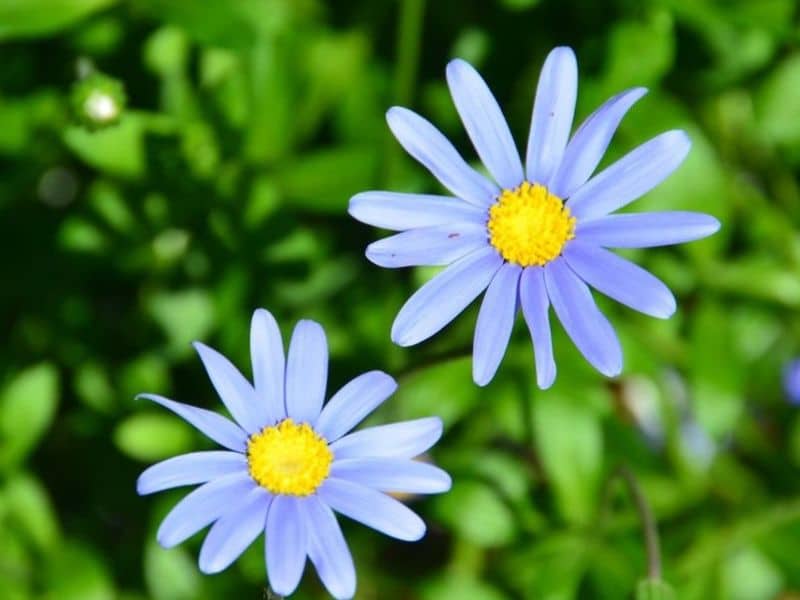
Daisies are very popular for garden arrangements and designs and are a classic choice preferred by most gardeners. One of the reasons for this is the fact that they are relatively easy to grow and care and grow fast.
The blue daisy is also resistant to rapid changes in the weather, big amplitudes of temperatures and wind. It likes moderately watered soil which is decreasing the efforts made to care for it significantly.
Blue daisies are considered to be one of the most unique and prettiest flowers of this sort due to the contract between the blue blossoms and their yellow center. This is the flower associated with simplicity and appreciation.
#46. Anemone
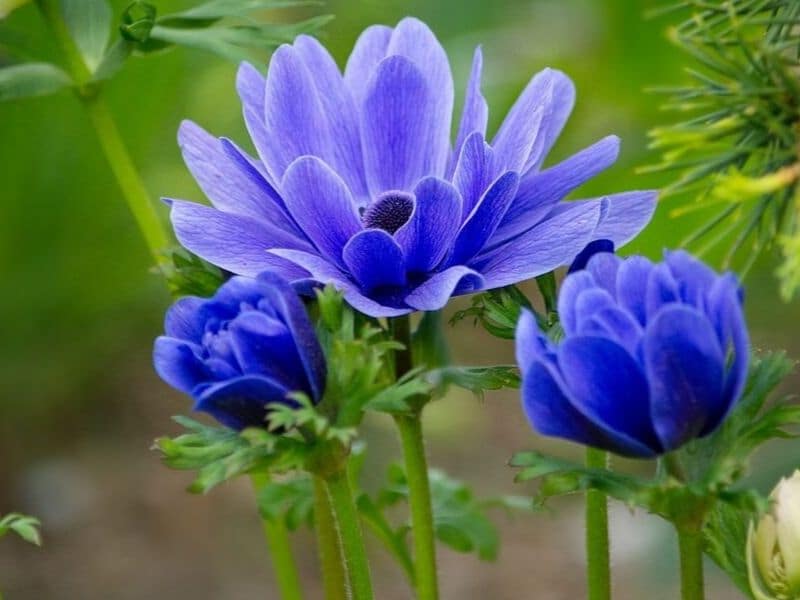
This flower comes in strong color options and blooms in three out of four seasons – all except winter, which makes it a good addition to any garden. It is a symbol of luck and has inspirational blossoms that are perceived by most people as pretty, dreamy and bringing spiritual peace of mind.
It grows only three months after the bulbs are planted and can give your garden up to 20 bright blue blooms per bulb if taken care of properly.
#47. Scabiosa
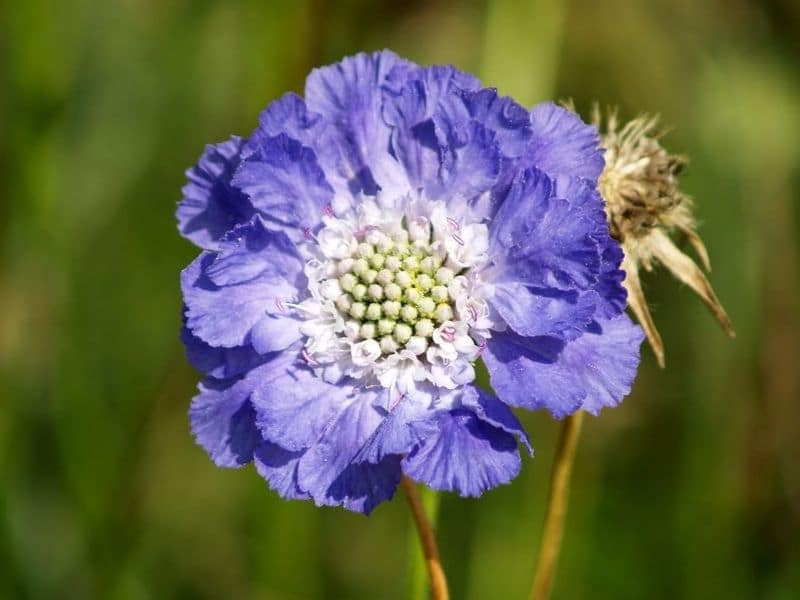
This is also a preferred flower for gardens due to the relative ease of growing and care. It is resistant to drier periods and higher temperatures and grows stronger in well-drained soil.
It blooms during the whole summer season. If you want to encourage stronger and more intense blooming, you have to remove the old flowers after they dry.
#48. Sea Holly
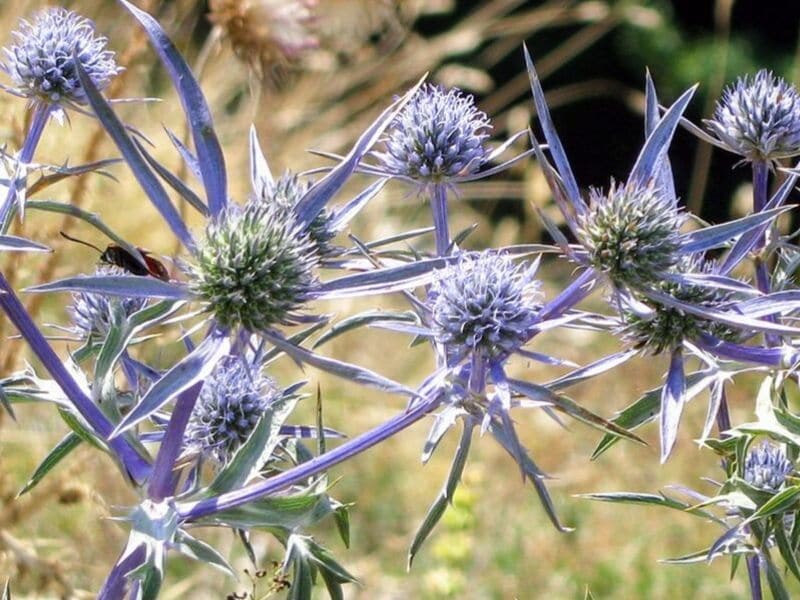
These distinctive pincushion flowers are also preferred as an addition to gardens that do not need so much effort to be maintained and are located in drier areas.
Also known as eryngium, it grows best in poor and dry soil and does not need regular watering or fertilizers, which makes it favorable for people who cannot dedicate a lot of time and effort to take care of their landscapes.
#49. Chicory
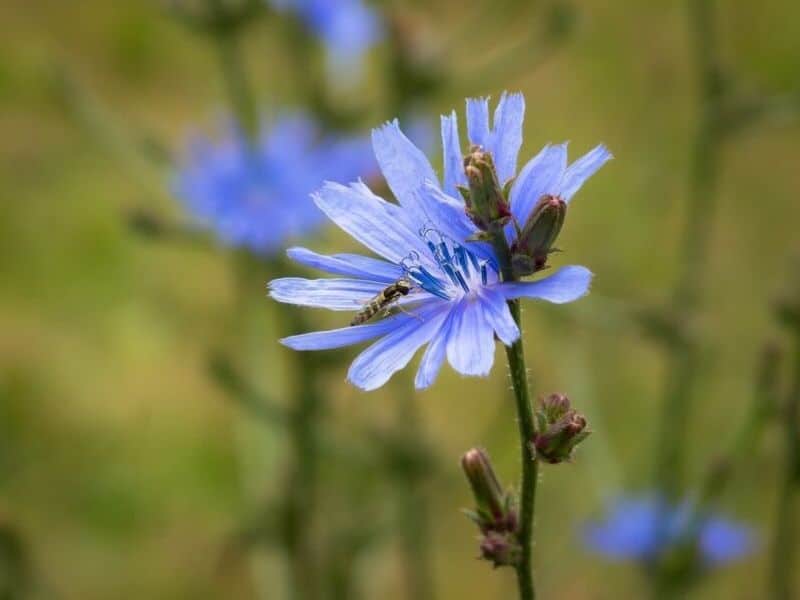
Sometimes can be known as Blue Dandelion, chicory flower is very often used as a symbol of love, desire, affection, and sympathy and this is why it has been considered as an important part of many traditions in the past.
Despite being native to Europe and Asia, it is nowadays spread across the world and is a beautiful addition to modern home garden designs.
#50. Balloon Flower
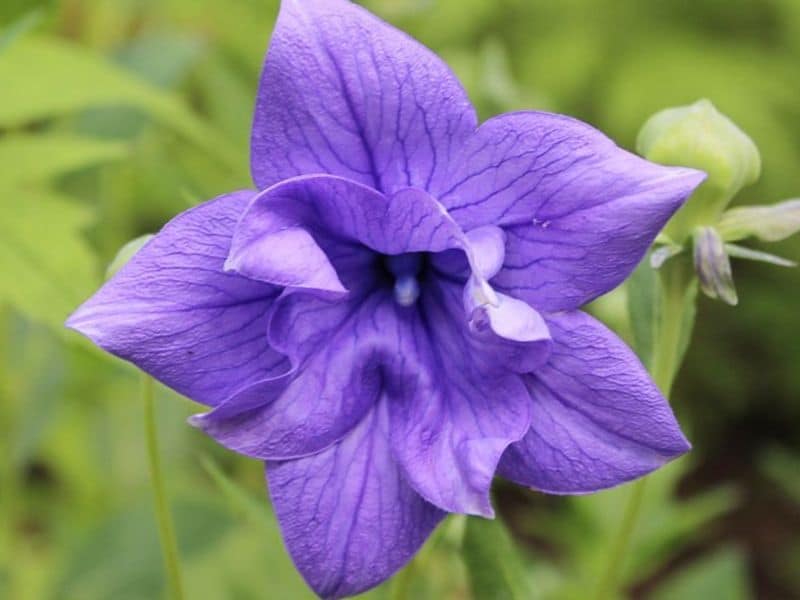
This flower is sometimes known as its scientific name 'platycodon grandiflorus'. As the name suggests, the blossoms of this flower are balloon-shaped buds mainly coming in three different colors, including blue, white and pink.
Balloon flowers are associated with love and honesty and are used in gardens as the beautiful and contrasting background of other colorful plants.
#51. Blue Hibiscus
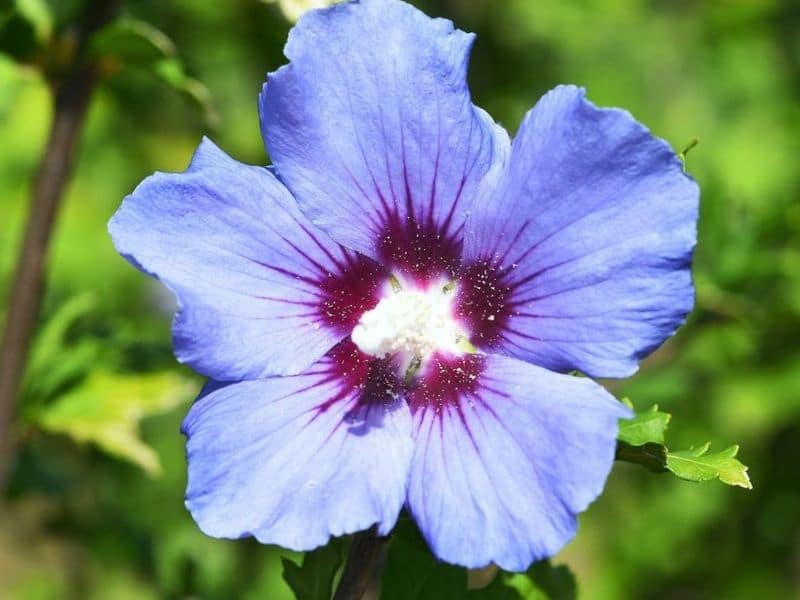
This is my most favorite flowers of all. Hibiscuses come in many colors including red, purple, pink, yellow and white, but specimens with pale blue flowers are the rarest to find. It is a delicate and breath-taking flower which is a symbol of infinity.
It blooms regularly in spring, summer and early autumn and likes full sun and regular watering. If taken care of well, the hibiscus flower will make your garden pretty during most of the year.
#52. Impatiens flower
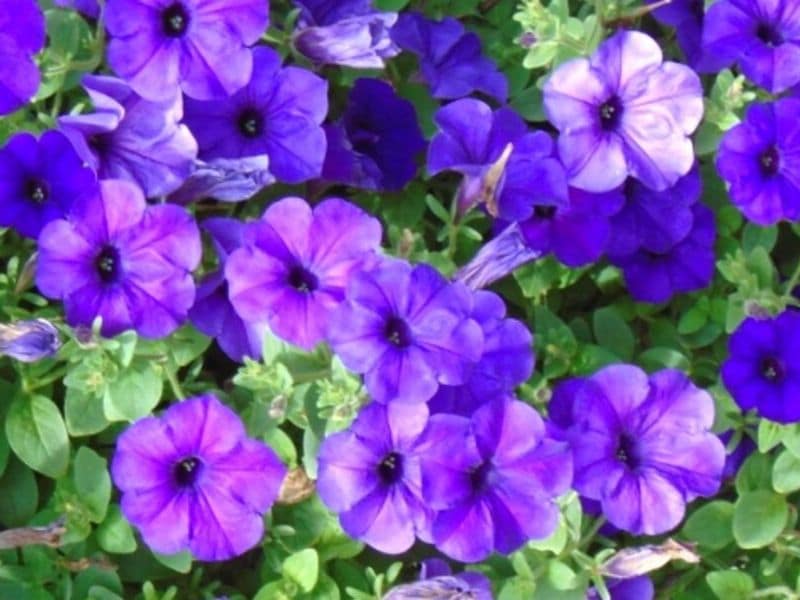
You can find this flower in two forms – flat-shaped and orchid-shaped. It is the symbol of motherly love.
#53. Violets

Violets are very often related to happiness and are not only a great colorful addition to your garden, but can also be a part of your home-made cuisine because they are edible flowers.
You can see them used as a decoration in plates serving desserts and salads or even as an ingredient in some more modern recipes.
#54. Blue Calla Lily
Calla lilies, Arum-lily, or Zantedeschia aethiopica are beautiful flowers that can give a breath-taking effect both to your garden and your floral vase arrangements. Because of their stylish shape and pretty blossoms they are very often used as the main decoration flowers for weddings and other events.
Generally, classic calla lilies came only in white in the past. After that, they started making hybrid cultivars coming in a variety of colors, including butterfly blue, pink, purple and even black.
The blue calla is perceived as a royal flower representing class, status, as well as gratitude and peace.
#55. Ipomoea Flower

This trumpet-shaped blossoms' flower comes in strong colors which opens its petals in the morning and closes them around noon time.
This is a climbing plant and is often used for decorating fences, walls and garden ornaments due to its strong rich colors contrasting with fresh greenery and sufficient height. It comes in a variety of colors, including blue, white, pink and purple.
References
Reference List
(1) Amsteus, M., Al-Shaaban, S., Wallin, E., Sjoqvist, S. (2015) Colors in Marketing: A Study of Color Associations and Context (in) Dependence. International Journal of Business and Social Science. Vol. 6 (3), pp. 32-45.
(2) Goi, C. (2012) The Impact of Colours on Online Marketing Communications. International Journal of Social, Behavioral, Educational, Economic, Business and Industrial Engineering. Vol. 6 (2), pp. 182-186.
(3) Won, S., Westland, S. (2017) Colour Meaning and Context. Color Research and Application. Vol. 42 (4), pp. 450-459.
(4) Zammitto, V. (2005) The Expressions of Colours. [online] Available: http://www.sfu.ca/~vzammitt/papers/zammitto-digra-TheExpressionsofColours.pdf
Photo credit: Pixabay.com
Close
Up Next: Top 25 Birth Month Flowers and Their Meanings with Pictures
bellloverrien1966.blogspot.com
Source: https://florgeous.com/blue-flowers/
Post a Comment for "Flower Comes in Variations of Purple Blue Yellow White"